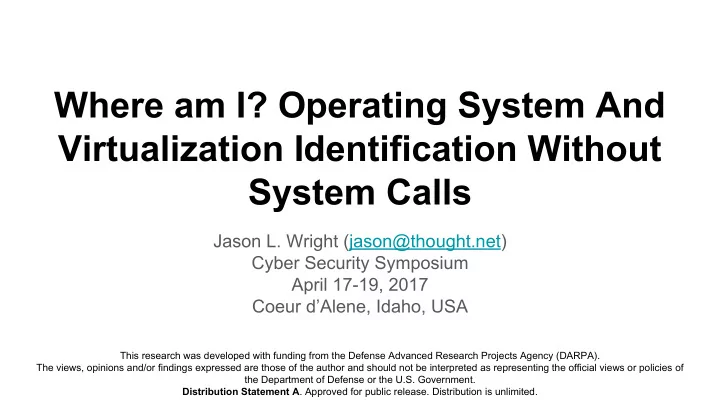

Where am I? Operating System And Virtualization Identification Without System Calls Jason L. Wright (jason@thought.net) Cyber Security Symposium April 17-19, 2017 Coeur d’Alene, Idaho, USA This research was developed with funding from the Defense Advanced Research Projects Agency (DARPA). The views, opinions and/or findings expressed are those of the author and should not be interpreted as representing the official views or policies of the Department of Defense or the U.S. Government. Distribution Statement A . Approved for public release. Distribution is unlimited.
What can I see? Given: ● Code execution ○ Arbitrary code ○ Unprivileged (user-level not kernel level) ○ Gather info without violating system call policy ● It’s about knowing: ○ what information is available ○ … and whether it is possible to monitor its access (or lie)
What is visible to user processes? ● Focus on x86 (32 and 64 bit, protected mode) ● General purpose registers: ○ EAX, EBX, ECX, EDX, EBP, ESP, ESI, EDI ● Normal segment selectors: ○ CS, DS, ES, FS, GS, SS ● Special segment selectors: ○ LDTR, TR ● Descriptor table registers: ○ GDTR, IDTR ● Machine Status Word: MSW
Segments: movl $1, (%eax) ● AT&T syntax (destination on the right) ● This means: move the constant 1 into the address stored in EAX ● In C: int *p = 1; // assuming p is stored in EAX ● The full address is DS:EAX DS is a segment selector (a 16 bit index into the OS controlled “Global Descriptor Table (GDT)” or “Local Descriptor Table (LDT)” ● Descriptor Table provides BASE, so virtual address is BASE+EAX ● Page tables turn BASE+EAX into the physical page of memory
So: MOV $1, (%EAX) Virtual address = DS:EAX BASE = GDT[DS].BASE Virtual address: DS:EAX = BASE + EAX Physical address = page table[virtual address]
Reading current segments Easy: PUSH CS; POP EAX Push the current code segment onto the stack, pop it back into EAX Works for all 6 “normal” segment selectors (CS, DS, ES, FS, GS, SS) SLDT and STR instructions for fetching LDT and TR segment selectors
Probing for segments LAR (load access rights) LSL (load segment limit) VERR (verify segment for reading) VERW (verify segment for writing) LAR and LSL allow probing for visibility of arbitrary segments Can be used to generate “segment map” of the current environment A list of valid segments, their type and their permissions
Segment Example: FreeBSD 10.2 64bit Segment 2 3 6 7 8 FS GS CS DS,ES,SS Process local Thread local 32bit code data 64bit code Segment Example: Windows 10 64bit Segment 4 5 6 10 DS, ES, GS, SS CS DS,ES,SS 32bit code data 64bit code Thread local
Machine Status Word (aka CR0) “SMSW is only useful in operating-system software. However, it is not a privileged instruction and can be used in application programs. The [instruction] is provided for compatibility with the Intel 286 processor.” Allows examination of Configuration Register 0 (CR0) One bit of differentiation power: Alignment Mask bit AM bit OS clear Windows (XP, 8.1, 10 i386), MacOS 10.11, OpenBSD set Windows (10 amd64, Server 2016), Linux, FreeBSD
Descriptor Tables “[SGDT, SIDT] [are] only useful in operating-system software. However, [they] can be used in application programs without causing an exception to be generated.” Retrieve the base and limit of the GDT or IDT (cannot access the contents of GDT/IDT, though)
GDT Identification Base Limit OS Base Limit OS Linux 3.13 domU FreeBSD 10.2 0x00 020000 0xeff 0x0000000 08169a450 0x0067 Windows XP SP3 OpenBSD 5.8 0x80 03f000 0x03ff 0xffff800 000011068 0x003f Windows 8.1 Linux 3.16 dom0 0x80 DCC000 0x03ff 0xffff820 000000000 0xefff Windows 10 Linux 3.16 domU 0x81 29C000 0x03ff 0xffff820 000020000 0xefff FreeBSD 10.3 Linux 3.16 0xc1 5b07a4 0x0097 0xffff880 02fc09000 0x007f OpenBSD 5.8 Windows 10 0xf4 e1c000 0xffff 0xfffff80 028dc3000 0x006f Linux 2.6.13 Windows Server 2016 0xf7 beb000 0x00ff 0xfffff80 089a54000 0x006f Linux 3.13 MacOS 10.11.6 0xf7 be6000 0x00ff 0xffffff8 000001000 0x0097 Linux 3.19 0xf7 14f000 0x00ff
Other sources of OS/Virtualization fingerprints ● IDTR (like GDT identification) ○ Linux fixmap IDT ● CPUID ○ Reserved leaf for hypervisors (EAX=0x40000000-4fffffff) ○ Hypervisor idiosyncrasies ■ Virtualbox RDRAND ■ Virtualbox XSAVE ● FPU initialization ○ FreeBSD 32bit initializes precision and reserved bit differently than everyone else
Future work ● Are there other sources of fingerprinting? ○ Are there mitigations? ● Would similar techniques work on other instruction sets? Availability ● Utility for fetching data exposed to user processes: ○ https://github.com/wrigjl/ucpuinfo ● Modified Linux, Xen, and FreeBSD patches: ○ https://github.com/CyberGrandChallenge
Recommend
More recommend